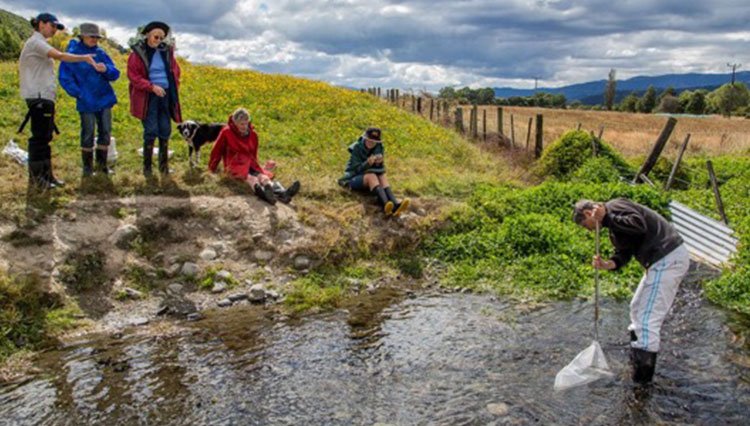What You Can Do In Your Catchment
What is a catchment? A catchment, or whaitua, is an area of land where rain flows into a common river, lake or other body of water. A healthy water catchment supports swimming, fishing, and local ecosystems. Find your catchment at NZ River maps
Join a catchment restoration group
Local community involvement is one of the keys to the long-term health of water in a catchment, so plants, animals, fish and insects that depend on having healthy water can thrive and flourish.
- See if there's a community-led catchment group in your area – check this map from NZ Landcare Trust – or a NZ Landcare Trust restoration project. Contact your regional office to be connected with one of 150 landcare groups in New Zealand.
- Get involved with community conservation groups working with the Department of Conservation around the country. You can also volunteer for a DOC project, or run your own project.
Start a catchment group
If there’s no existing group supporting your catchment, it’s possible to start one yourself, and there are plenty of resources to help. The best way to improve water quality in your catchment is to get everyone who lives along it together, identify problems and come up with collective solutions.
- Starting a catchment care group can be as simple as organising a rubbish pick-up from a riverbank once a year. Local schools may be keen to participate.
- NZ Landcare Trust can help you set up a catchment care group (or tell you if one already exists, or has formed in the past). They also produce a How To Start A Catchment Group brochure and an introductory guide for catchment communities working to improve freshwater, Catchment Management Working Together. A more detailed guide, Community-Owned Rural Catchment Management: A Guide for Partners, is also available.
- Department of Conservation has great info on how to start a conservation project, with guidelines and best practice.
- The Ministry for the Environment’s Community Environment Fund may help fund specific projects.
- Partnership Funding from One Billion Trees is available to communities for new ideas that support tree planting or for catchment planting projects.
Tips for a great catchment group
Lyndon Strang of the NOSLAM catchment group in North Otago has some great advice for catchment groups in the first 6 minutes of this video.
- We've developed a four-step plan for catchment groups to develop effective farm plans.
- Find Our Land and Water-backed communication and collaboration tools in the Toolbox.
- Living Water, a partnership between DOC and Fonterra with contributions from several Our Land and Water scientists, is trialling tools and solutions in 5 catchments around the country. Follow their progress for inspiration from this leading-edge project.
Measure your progress
It's important to use standard measurements for the land management actions being made to improve water quality in your catchment. This allows information from multiple farms and restoration projects to be compiled and linked to water quality outcomes. See our list of potential standard measurements below. Our ongoing work to create a Register of Land Management Actions for New Zealand will continue to refine and improve this list.
- Beef and Lamb NZ has a short fact sheet on Community Based Freshwater Monitoring.
- You can assess your local stream health using NIWA’s stream health monitoring and assessment kit, SHMAK. This kit enables non-scientists to collect consistent, scientifically valid information from small rural streams.
- NZ Water Citizens is a website, developed by NIWA, for volunteer stream monitoring. The site provides a database for storing, understanding, presenting your data, and for viewing data from other sites. It also includes resources to help you learn methods for stream monitoring and a forum for information sharing.
- Mountains to Sea has resources for monitoring freshwater fish.
- LAWA displays information on freshwater quality from over 1,100 monitoring sites and provides fact sheets.
- Landcare Trust’s Wetlands Monitoring and Assessment Kit may also be useful.
Get involved in catchment planning
Your regional council is responsible for decisions about the freshwater catchments, lakes and rivers in your region. If you’re interested in how your local river or lake is being managed, we encourage you to find out more about what your regional council is doing and get involved.
- Many councils run full collaborative planning processes to make planning decisions about fresh water. Keep an eye on your regional council website for opportunities to be involved.
- When a regional council makes or changes a regional plan it is required to notify the public. That’s your opportunity to make a submission. You can also sometimes make submissions on individual resource consent applications.
- Beef and Lamb NZ has advice on its website for those who would like to influence regional council decision-makers (audio | PDF).
 View Our Strategy Document 2019 – 2024
View Our Strategy Document 2019 – 2024



